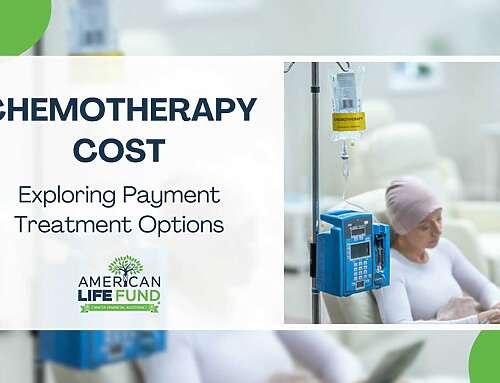Head and neck cancer treatment can be very expensive, costing between $65,000 and $200,000. These costs include surgery, chemotherapy, radiation, indirect costs like travel, and lost wages. Understanding your insurance coverage and financial help from government programs, nonprofits, and viatical settlements, which let you sell your life insurance policy for immediate funds. Talking to your healthcare providers, checking your insurance benefits, and finding affordable treatment options can help manage these costs.

Stages of Head and Neck Cancer and Their Impact on Costs
The stage of head and neck cancer shapes treatment costs. Reviewing insights from various healthcare sources, early-stage head and neck cancer treatment can range from $38,000 to $110,000, while advanced-stage treatment has a rising cost, stretching from $75,000 to $200,000. The number of treatment modalities required is the primary factor of cost. This breakdown reveals stage-specific expenses:
Stage 0 (Carcinoma in situ): $60,000 (6 months after diagnosis)
Stage 1: $85,000
Stage 2: $100,000
Stage 3: $135,000
Stage 4: $175,000
These figures include procedures, treatments, and medications tailored to each stage, highlighting the cost-effectiveness of early intervention in controlling the disease.
Treating head and neck cancer involves clear cost estimates.
Common treatments have specific prices, like:
- Surgery
- Radiation therapy
- Targeted therapy
- Immunotherapy
- Chemotherapy
Chemotherapy in the United States can cost anywhere from $2,000 to $10,000 monthly for head and neck cancer patients.
Radiation treatment averages about $7,000 to $12,000 monthly, and immunotherapy typically costs between $10,000 and $30,000 monthly. Targeted therapy costs vary greatly, from $5,000 to $15,000 monthly. Recognizing that these costs can vary based on individual situations, insurance coverage, and healthcare providers is important for patients when deciding on their healthcare.
Insurance Coverage and Its Role in Treatment Costs
Different insurance plans provide different levels of coverage, and the total cost you may take on can vary greatly. Understanding your health insurance benefits by examining specific coverage details is important to ensure your medical expenses for head and neck cancer treatment are properly covered, easing the financial strain.
We will take a look at different avenues for receiving financial assistance, such as government programs, nonprofit organizations, advocacy groups, and clinical trials. These resources are designed to offer practical support to patients facing the economic challenges of head and neck cancer treatment.
Direct and Indirect Expenses in Head and Neck Cancer Treatment
Understanding the full scope of expenses in head and neck cancer treatment involves both direct and indirect costs. Direct medical costs include treatments, medications, and hospital stays, with the average direct medical expenses potentially changing due to factors like the specific type of head and neck cancer, stage, and insurance coverage.
Indirect expenses such as lost wages, transportation, childcare or eldercare, home modifications, complementary therapies, and emotional support, add significant financial considerations. The cost estimates of ongoing care post-treatment and continuing therapies vary, affecting overall financial planning and the economic burden.
Direct Medical Costs
Direct medical costs are important in the total cost of treatment of head and neck cancers. These costs include treatments, medications, and hospital stays. In the United States, the expenses for head and neck cancer care can fluctuate significantly based on the treatment approach and stage of the cancer. Understanding these costs is important for patients to create a plan that includes their financial situation lessening the economic burden.
Indirect Expenses
Patients treated with head and neck cancer face not only direct medical costs but also indirect expenses that can add up quickly. These include lost wages from time off work, transportation costs to and from treatment, and possible home modifications. The average total cost of care following treatment and ongoing therapies can affect the overall financial burden patients and their families face, requiring careful planning and consideration of these indirect expenses.
Financial Assistance Options for Head and Neck Cancer Patients
Facing the financial challenges of head and neck cancer treatment requires exploring multiple financial assistance options. These include:
Government Programs:
Programs like Medicaid, Medicare, and Social Security benefits can provide crucial support. Eligibility can differ, so it’s important to consult with your state’s programs for specific information.
Nonprofit Organizations and Advocacy Groups:
Organizations dedicated to head and neck cancer provide grants and financial aid to help patients cope with expenses. These resources can offer financial relief, and patients should investigate eligibility to access available assistance.
Clinical Trials:
Participating in clinical trials and health services research may offer patients access to new treatments at reduced or no out-of-pocket cost, potentially easing the financial burden. Eligibility requirements differ, so patients should discuss potential trials with their healthcare providers.
Tips for Managing Head and Neck Cancer Treatment Costs
Effectively managing the out-of-pocket costs associated with head and neck cancer treatment involves well-thought-out planning and communication. Patients should engage openly with their healthcare providers about the total cost, inquire about payment plans or financial assistance, and maintain records of all healthcare-related expenses. By actively seeking information and assistance, patients can better manage the economic burden of their treatment journey.
Understanding Health Insurance Benefits
Patients must navigate their treatment options with a clear understanding of their health insurance benefits. Health insurance typically covers multiple aspects of head and neck cancer therapies, including surgeries, chemotherapy, conventional radiation therapy, medications, diagnostic tests, inpatient costs, and follow-up cancer care.
The extent of coverage can differ greatly among individual insurance plans. Reviewing your insurance policy in detail and grasping its limitations and extent of coverage is essential for minimizing out-of-pocket costs for head and neck cancer care.
Exploring Generic Drugs and Discounts
For managing head and neck cancer treatment costs, considering cost-effective alternatives like generic drugs and seeking available discounts is a smart approach. Generic medications provide the same success rates and safety standards as their brand-name versions but are usually more affordable. Prescription drug benefits, including discounts, can be made through different programs and organizations such as the Patient Access Network Foundation, Prescription Hope, and NeedyMeds.
Trusted resources for locating medication coupons or discounts include prescription assistance programs featured on the American Cancer Society website, advice from pharmacists, and dedicated cost-saving websites. By investigating these resources, patients can make more financially informed decisions regarding their head and neck cancer care.
Viatical Settlements: A Financial Option for Head and Neck Cancer Patients
When facing the challenges of head and neck cancer, individuals and their families often encounter significant financial pressures. Viatical settlements, such as those offered by American Life Fund, are a financial solution to consider.
Understanding Viatical Settlements:
A viatical settlement involves selling a life insurance policy to a third party for a lump sum payment. This financial strategy is typically used by individuals dealing with life-threatening illnesses, such as head and neck cancer, who are in urgent need of funds to cover medical expenses and other financial needs.
How American Life Fund Supports:
American Life Fund specializes in viatical settlements and aims to assist individuals suffering from severe illnesses, including head and neck cancer. By choosing a viatical settlement, patients can gain access to a lump sum payout quickly, helping to alleviate immediate financial concerns without the wait associated with traditional life insurance claim processes.
Advantages of Viatical Settlements for Head and Neck Cancer Patients:
Immediate Financial Relief: The primary feature of a viatical settlement is that it allows a person with a life-threatening illness a rapid source of funding, offering essential financial support during the difficult journey of head and neck cancer treatment.
Flexibility of Use: The lump sum obtained from a viatical settlement can be used for a range of purposes, from covering medical bills to exploring alternative therapies or improving quality of life.
No Repayment Required: Viatical settlements are not loans, so there is no obligation to repay the amount received. This allows patients to use the funds as needed without increasing the financial burden.
Factors to Consider Before Choosing a Viatical Settlement:
Impact on Life Insurance: Opting for a viatical settlement means selling your life insurance policy, which will affect the policyholder’s coverage. It’s essential to consider the trade-offs before proceeding.
Seeking Professional Advice: It is recommended that patients consult with financial advisors, healthcare providers, and legal professionals to fully understand the ramifications and ensure an informed decision.
While viatical settlements may not be the right choice for everyone, they offer a potential financial resource for head and neck cancer patients in need of immediate financial assistance. Organizations like American Life Fund guide during these trying times, helping individuals explore their financial options with empathy and expertise.
Summary
Navigating the financial landscape of head and neck cancer treatment requires an understanding of both direct and indirect expenses. Direct medical costs, which include treatments, medications, and hospital stays, range from $38,000 to $175,000, with the total cost of post-treatment care averaging significantly in the first year. Indirect expenses, such as lost wages, transportation, and complementary therapies, add to the financial considerations for patients and their families.
Financial assistance options are important in reducing the economic strain. Government programs like Medicaid and Medicare provide support, while nonprofit organizations and advocacy groups offer financial assistance through grants and other aid. Clinical trials present opportunities to access new and innovative treatments at reduced or no out-of-pocket costs.
Effective management of head and neck cancer treatment costs includes:
- Clear communication with healthcare providers.
- A thorough understanding of health insurance benefits.
- The exploration of cost-effective alternatives, such as generic drugs and available discounts.
By following these guidelines, patients can make well-informed decisions about their care while mitigating the financial impact of head and neck cancer treatment.
Frequently Asked Questions
What is the average cost of head and neck cancer treatment?
The average cost of head and neck cancer treatment can change significantly depending on factors like the stage, type, and length of treatment. Estimates range from $38,000 to $175,000. Typically, insured patients may be responsible for 10 to 15 percent of the bill.
How much does treating head and neck cancer in the first stage cost?
On average, the cost of treating first-stage head and neck cancer can be around $75,000 over two years. These costs are influenced by various factors, including the type of treatments such as surgery, radiation therapy, and chemotherapy.
Does insurance cover head and neck cancer treatment?
Most insurance plans offer some level of coverage for head and neck cancer treatment, but the extent and out-of-pocket costs can differ significantly. It is essential to thoroughly review and understand your insurance policy’s details.
What are some examples of direct and indirect expenses in head and neck cancer treatment?
Direct expenses for head and neck cancer include treatments, medications, and hospital stays, with costs generally ranging from $38,000 to $175,000. Indirect expenses cover lost wages, transportation, childcare, home modifications, and psychological support, with average costs potentially significant in the first year after diagnosis.
Are government programs available to help with head and neck cancer treatment costs?
Yes, there are government programs such as Medicaid, Medicare, Social Security Disability Insurance (SSDI), and Supplemental Security Income (SSI) available to assist individuals undergoing head and neck cancer treatment. Eligibility varies by program.
What financial assistance options are available for head and neck cancer patients?
Financial aid for head and neck cancer patients includes support from government programs (like Medicaid and Medicare), nonprofit organizations specializing in cancer care, and participation in clinical trials. These avenues provide different types of financial relief to help manage the out-of-pocket costs associated with treatment.
How can patients manage head and neck cancer treatment costs effectively?
Patients can effectively manage treatment out-of-pocket costs by maintaining open communication with healthcare providers, thoroughly understanding their health insurance coverage, exploring cost-saving measures such as generic drugs and discounts, and seeking financial help from government programs, nonprofit organizations, and clinical trials. These strategies help patients make informed healthcare decisions while minimizing out-of-pocket expenses.





